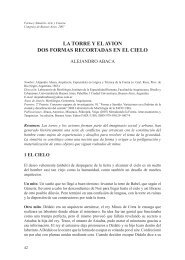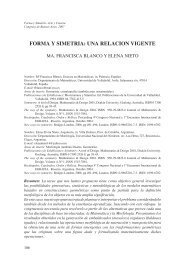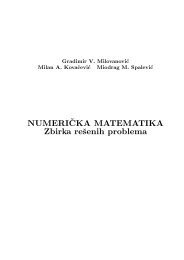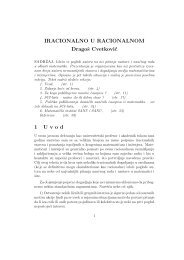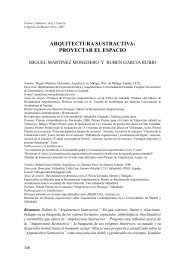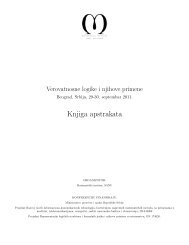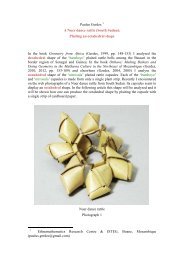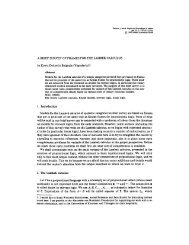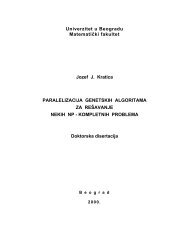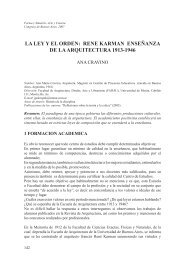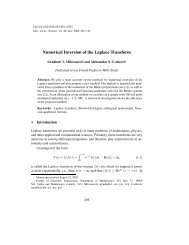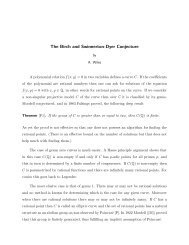ON GENERALIZED STIRLING NUMBERS AND POLYNOMIALS
ON GENERALIZED STIRLING NUMBERS AND POLYNOMIALS
ON GENERALIZED STIRLING NUMBERS AND POLYNOMIALS
You also want an ePaper? Increase the reach of your titles
YUMPU automatically turns print PDFs into web optimized ePapers that Google loves.
<strong>ON</strong> <strong>GENERALIZED</strong> <strong>STIRLING</strong> <strong>NUMBERS</strong> <strong>AND</strong><strong>POLYNOMIALS</strong>Nenad P. Cakić and Gradimir V. MilovanovićSummary. In this paper we prove that some results concerned the generalized Stirling numbersare the consequence of the results of Toscano and Chak. The new explicit expressions for generalizedStirling numbers are also given.1. INTRODUCTI<strong>ON</strong>The Stirling numbers of the second kind and the corresponding polynomials,so called, single variable Bell polynomials (see [7],[12]),are defined by(1)and(2)S(n, k) = 1 ( )k∑ k(−1) k−i i n = (−1)k ∆ k 0 nk!i k!i=0A n (x) =n∑S(n, k)x k ,k=0respectively.Singh ([14]), Sinha and Dhawan ([17]), and Shrivastava ([13]), studied thegeneralized Stirling numbers and polynomials defined, respectively, by(3)and(4)S (α) (n, k, r) = (−1)kk!T (α)n (x, r, −p) =It is easily verified from (4) that( )k∑ k(−1) j (α + rj) njj=0n∑S (α) (n, k, r)p k x rk .k=0T n(α) (x, r, p) = x −α e pxr (xD) n x α e −pxri.e the generalized Truesdell polynomials ([19]).Singh’s generalization was motivated by the generalization of Hermite polynomialsof Gould-Hopper ([8]) given byH (r)n (x, α, p) = (−1) n x −α e pxr D n (x α e −pxr ).1
Singh Chandel introduced the following generalizations of the Stirling numbersand polynomials (see [15]):(5)and(6)whereS (α,λ) (n, k, r) = (−1)kk!T (α,λ)( )k∑ k(−1) j (α + rj) (λ−1,n) ,jj=0nn (x, r, −p) = x n(λ−1) ∑S (α,λ) (n, k, r)p k x rka (λ−1,n) =k=o( ) a(λ − 1) n .λ − 1 nEvidently, when λ → 1, equations (5) and (6) would reduce to (3) and (4)respectively, which, in turns, will yield (1) and (2), respectively for r−1 = α = 0.In this paper we prove that the generalizations (3) and (4) and relatedproperties are an old result, published in 1887. by d’Ocagne ([11]). Also, weprove that Singh Chandel result is the consequence of the fundametal results ofToscano ([19]) and Chak ([6]).The new explicit expressions for numbers (3) and (5) are also given.2. <strong>ON</strong> A RESULT OF R. P. SINGHOne of the first generalization of the Stirling numbers of the second kind (1)is given by d’Ocagne (see [11]):(7)with the recurrence relationS (α) (n, k) = (−1)kk!( )k∑ k(−1) j (α + j) njj=0(8)S (α) (n, k) = S (α) (n − 1, k − 1) + (k + α)S (α) (n − 1, k)Toscano introduced similar numbers and related polynomials in many papers(see for example [18] and [19] for references).For numbers defined by (7), we have the generating function, recurrencerelations (see [19]):(9)∞∑S (α) (n, k) tnn! = (−1)k e αt (1 − e t ) k ,k!n=02
( )n∑ n(10) S (α) (n + 1, k) − αS (α) (n, k) = S (α) (i, k − 1),ii=0(n∑ j(11)(α + j) n = i!Si)(a) (n, k)i=0and related polynomialsA n (x, α) =with generating function (see [6]):n∑S (α) (n, k)x kk=0(12)∞∑n=0t nn! A n(x, α) = e αt−x(1−et) .Starting with the recurrence relation for numbers S (α) (n, k) (8), and usingsupstitution α → α r, we getr n S ( α r ) (n, k) = rr n−1 S ( α r ) (n − 1, k − 1) + (α + rk)r n−1 S ( α r ) (n − 1, k)We see that(13)S (α) (n, k, r) = r n S ( α r ) (n, k)because the recurrence relation for numbers S (α) (n, k, r) isS (α) (n, k, r) = rS (α) (n − 1, k − 1, r) + (α + rk)S (α) (n − 1, k, r)In the same way from (10) and (11), we have other recurrences which are provedby Sinha and Dhawan [17] and Shrivastava [13].Now, we consider the generating function (9). Using supstitution α → α rand relation (13), we get∞∑n=0S (α) (n, k, r) tnn! = ∞ ∑n=0S ( α r ) (n, k) (rt)nn!= (−1)k e αt (1 − e rt ) k ,k!i.e the result from [17] and [13].For the polynomials T n (α) (x, r, −p), using supstitution x → px r , α → α r andt → rt, we have from (12)∞∑ (rt) nA n (px r , α n! r ) = (1−e rt )eαt−pxrn=03
which is the result for the generalized polynomials T n(α) (x, r, −p) from [17] and[13].Remark 1. From (3) we get directly relation (13), because (α + rj) n = r n ( α r + j)n .Remark 2. The fact T n(α) (x, r, −p) = r n A n(px r , α ) Toscano also found in [19], in a different way,rusing differential operators.3. <strong>ON</strong> A RESULT OF R. C. SINGH CH<strong>AND</strong>ELThe main results from the paper [15] are the consequence of the results fromA.M.Chak [6].Starting with the following notation by Singh Chandel( ) αα (k−1.n) = (k − 1) n =k − 1 nα(α + k − 1) · · · (α + (k − 1)(n − 1))we see that(α + rj) (k−1,n) = r n ( αr + j ) (k−1r ,n) ,and so, from (5), we haveS (α,λ) (n, k, r) = (−1)kk!( )k∑ k(−1) j r n ( α j rj=0+ j)(λ−1r ,n) = r n A ( α r , λ r )n,kwhere A (α,λ)n.kare numbers defined by A.M.Chak [6] in the following way(x λ D) n = x (n−1)λ n ∑i=0A (α,λ)n,i x i+α D i x −α .So, using proved equations and the recurrence from [6]we get a recurrence from [15]A (α,λ)n+1,k = A(α,λ) n,k−1+ (nλ − n + α + k)A(α,λ)n,kS (α,λ) (n + 1, k, r) = rS (α,λ) (n, k − 1, r) + (nλ − n + α + rk)S (α,λ) (n, k, r)For polynomials treated in [15] we get from (6) easilyT (α,λ)n (x, r, −p) = r n x n(λ−1) G ( α r )(−px r )where G (α)n,λ(x) are a class of polynomials from [6].n, λ r4
4. EXPLICIT EXPRESSI<strong>ON</strong>S FORS (α) (n, k, r) <strong>AND</strong> S (α,λ) (n, k, r)In this section we use the results from Cakić [1](see Theorem 4. and commentby L.Carlitz) and Milovanović and Cakić [10] (see Theorem 3.)Applying Carlitz’s [2] extension of a result of Wang [20], Singh Chandel andDwivedi [16] proved the following explicit formula for S (0,λ) (n, k, r) :S (0,λ) (n, k, r) = n! ∑ k∏ r (λ−1,i l),k!ii 1 +···+i k =n l=1 l !where i s > 0.In this section we prove the theorem about new explicit expressions fornumbers S (α) (n, k, r) and S (α,λ) (n, k, r).Theorem: We have(14)and(15)S (α) (n, k, r) = r n ∑ ( )α/r n−1( )∏ α/r + s − Ss,i 0 is=1 sS (α,λ) (n, k, r) = r n ∑ ( )α/r n−1( )∏ α/r + s(λ−1r+ 1) − S si 0 is=1 swhere S s = ∑ s−1t=0 i t. The summation on the right in above sums is over alli 0 , . . . , i n−1 ∈ {0, 1} such that i 0 + i 1 + · · · + i n−1 = n − k.P r o o f:Introduce the notations( )α/rn−2( )∏ α/r + s − SsA(i 0 , . . . , i n−2 ) =,i 0 is=1 sandB(i 0 , . . . , i n−2 ) =( )α/rn−2( )∏ α/r + s(λ−1r+ 1) − S s.i 0 is=1 sFor i n−1 ∈ {0, 1} we get from (14) and (15), respectively:S (α) (n, k, r) = r n∑S n−1 =(n−1)−(k−1)r n (α/r + n − 1 − (n − k − 1))5A(i 0 , . . . , i n−2 )+∑S n−1 =(n−1)−kA(i 0 , . . . , i n−2 ),
andi.e.andS (α,λ) (n, k, r) = r n ∑B(i 0 , . . . , i n−2 )+S n−1 =(n−1)−(k−1)r n (α/r + (n − 1)((λ − 1)/r + k))∑B(i 0 , . . . , i n−2 ),S n−1 =(n−1)−kS (α) (n, k, r) = rS (α) (n − 1, k − 1, r) + (α + rk)S (α) (n − 1, k, r)S (α,λ) (n, k, r) =rS (α,λ) (n − 1, k − 1, r) + ((n − 1)(λ − 1) + α + rk)S (α,λ) (n − 1, k, r).For k = 0 and k = n, we haveandThis completes the proof.S (α) (n, 0, r) = α n , S (α) (n, n, r) = r nn−1S (α,λ) (n, 0, r) = r n ∏( α r + sλ − 1 ) = α (λ−1,n) ,r✷s=0S (α,λ) (n, n, r) = r n .Remark 3. In above theorem we use the convention: if α = 0 then i 0 = 0.Notice that for bigger values of k(k > [n/2]) this formulas are simpler thanclassical expressions (3) and (5). For example, if we take k = n − 1, then from(3) and (5) we find, respectively( )S (α) (n, n − 1, r) = (−1)n−1 n−1 ∑ n − 1(−1) j (α + rj) n ,(n − 1)!jj=0( )S (α,λ) (n, n − 1, r) = (−1)n−1 n−1 ∑ n − 1(−1) j (α + rj) (λ−1,n) ,(n − 1)!jj=0while representations (14) and (15) give, respectively(n2)S (α) (n, n − 1, r) = nαr n−1 +S (α,λ) (n, n − 1, r) = nαr n−1 +(n2)r n ,((λ − 1)/r + 1)r n .6
5. SPECIAL CASESSome important special cases of numbers S (α) (n, k, r) and S (α,λ) (n, k, r)are: ” Weighted Stirling numbers of the second kind ” ([4], [5]): R(n, k, λ) =S (λ) (n, k, 1) = S (λ,1) (n, k, 1), ” Degenerate Stirling numbers of the second kind” ([3]): S(n, k|θ) = S (0,1−θ) (n, k, 1), ” Degenerate weighted Stirling numbers ofthe second kind ” ([9]): S(n, k, λ|θ) = S (λ,1−θ) (n, k, 1).REFERENCES1. N. P. Cakić. ”On Some Combinatorial Identities. ”Univ. BeogradPubl.Elektrotehn.Fak.Ser.Mat.Fiz.No.678-715(1980): 91-94.2. L. Carlitz. ”Note on a Binomial Identity.” Bolletino U.M.I.(4)9(1974):644-646.3. L. Carlitz. ”Degenerate Stirling, Bernoulli and Eulerian Numbers.” UtilitasMath.15(1979):51-88.4. L. Carlitz. ”Weighted Stirling Numbers of the First and Second kindI”.The Fibonacci Quarterly 18(1980):147-162.5. L. Carlitz. ”Weighted Stirling Numbers of the First and Second kindII.”The Fibonacci Quarterly 18(1980):242-257.6. A. M. Chak. ”A Class of Polynomials and Generalized Stirling Numbers.”Duke Math.Jour. 23 (1956):45-55.7. L. Comtet. Advanced Combinatorics, Reidel, Dordrecht, 1974.8. H. W. Gould & A. T. Hopper. ”Operational Formulas connected withtwo Generalizations of Hermite Polynomials.” Duke Math.Jour.29(1962): 51-64.9. F. T. Howard. ”Degenerate Weighted Stirling Numbers.” Discrete Math.57(1985):45-58.10. G. V. Milovanović & N. P. Cakić. ”Explicit Formulas for Numbers ofCarlitz and Toscano. ”Facta Universitatis Ser.Math.Inform.9(1994):1-5.11. M. d’Ocagne. ”Sur une classe de numbres remarquables”. Amer. J.Math.9(1887): 353-380.7
12. J. Riordan. An Introduction to Combinatorial Analysis. New York: Wiley,1958.13. P. N. Shrivastava. ”On Generalized Stirling Numbers and Polynomials.”Riv. Mat. Univ. Parma (2) 11(1970): 233-237.14. R.P.Singh. ”On Generalized Truesdell Polynomials.” Riv. Mat. Univ.Parma (2) 8(1967): 345-353.15. R.C. Singh Chandel. ”Generalized Stirling Numbers and Polynomials.”Publ. Inst. Math. N.S. 22(36)1977:43-48.16. R. C. Singh Chandel & B. N. Dwiwedi. ”A Note on Some Binomial andExponential Identities.”Ranchi Univ. Math. J. 10(1979): 33-38.17. V. P. Sinha & G. K. Dhawan. ”On Generalized Stirling Numbers andPolynomials.”Riv. Mat. Univ. Parma (2) 10(1969): 95-100.18. L. Toscano. ”Sulla iterazione dell’operatore xD.” Rendiconti di Matematicae delle sue applicazioni. 5(VIII)(1949): 337-350.19. L. Toscano. ”Generalizzazioni dei polinomi di Laguerre e dei polinomiattuariali.”Riv. Mat. Univ. Parma. (2) 11(1970): 191-226.20. P. C. C. Wang. ”A Binomial Identity with an Application to Sequence ofSymmetric Bernoulli Trails.”Rend. Sem. Fac. Sci. Univ. Cagliari.39(1969):153-155.Faculty of Electrical Engineering, Dept. of Math.,P.O.Box 35-54,11120 Belgrade, Serbia and Montenegro e-mail:cakic@kondor.etf.bg.ac.yuFaculty of Electronic Engineering, Dept. of Math.,P.O.Box 73, 18000 Niš, Serbia and Montenegroe-mail: gvm@bankerinter.netAMS Classification Numbers:05A15, 05A19, 05A108



